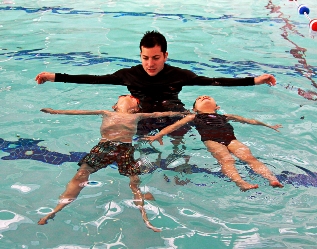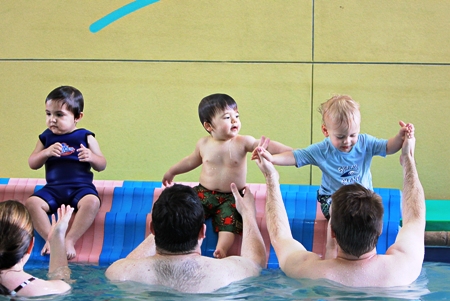Scary statistics
The statistics on drowning are enough to scare any parent of an infant or toddler :- A child can drown at the time it takes to answer a phone call

- Children under the age of five and adolescents have the highest drowning rates
- For every child who drowns, four others are hospitalized for a near drowning.
- Drowning is the leading cause of injury or death for children ages 1 to 4, according to the Centers for Disease Control and Prevention.
Never too young for lessons
The solution: Parents should seriously consider water-survival skills training for their kids. The problem is that lots of parents are hesitant to start their children because they think they aren't old enough, they are too scared, or that it won't be fun. My question to those parents is always, "What is old enough when some children are already drowning before they reach their first birthday?" As for the fun part, my view is that learning to be water-safe does not have to be fun; it is a skill that must be learned, sooner rather than later. There will be plenty of time for fun in the water, but it only comes after a child is water-safe and able to navigate in the water on their own.
My view is supported by the American Academy of Pediatrics (1,2), which in 2010 relaxed its opposition to swim lessons for infants and toddlers and issued updated water safety and drowning prevention advice (1) for parents, dropping opposition to swimming lessons for infants and toddlers.
I believe that there is tremendous value starting infants in swimming lessons as soon as possible. Babies do not have any bad habits, which allow instructors to lay a solid foundation without much resistance. Naturally, many parents are reluctant to start swimming lessons for their infants with a stranger, so even if they take parent-tot classes where they can be in the water with the child, it is already a big step towards getting their child comfortable in the water.
Cry babies
Another common obstacle parents face is seeing their children crying in the water when they first start swim lessons, which prompts a quick decision to pull them out of lessons in the belief that their child is not ready yet. The fact is that every child is ready for lessons when they come to the pool. Some take longer than others to adjust, some will cry and rebel, but eventually they will adjust and start feeling comfortable enough to transition into the learning phase. It is the parents who give up on lessons, not the kids.

My recommendation to parents is that if you can't handle your child crying during lessons, just leave the pool deck during the class, don't watch, but, above all, DON'T GIVE UP. Remember, learning to be water safe is not going to be fun, fun comes later when your child is water safe.
Swim year-round, not just in summer
Swimming is a wonderful activity that can and should be done all year. A lot of parents still have the idea that swimming lessons are a summer-only activity. Ask yourself this question: what happens to a three- or four-year old child who has taken swimming lessons three times a week for the whole summer, but doesn't return to the pool until the following summer? By the time next summer rolls around that child will have forgotten everything he learned. That's why I highly recommend taking one or two lessons a week throughout the year, as this will help your child attain safety and swimming skills faster.
Remember, though, that, as parents, you always need to be aware of where your kids are at all times, and to keep your eyes on your child when they are in or near the water, because anything can happen.
Lenny Krayzelburg is four-time Olympic swimming gold medalist, former professional swimmer and the founder of the Lenny Krayzelburg Swim Academy, which operates two schools in Southern California and seven partnership sites around the country which focus on a safety-first teaching method, where students must past a survival test before they learn any swim techniques. Once the child has passed their water safety test, they are then able to move onto learning the fundamental, basic techniques of swimming.
Footnotes:
1. American Academy of Pediatrics, Committee on Injury, Violence, and Poison Prevention. "Policy Statement - Prevention of Drowning." Pediatrics (published online May 24, 2010)
2. Weiss J., Committee on Injury, Violence, and Poison Prevention. Prevention of Drowning. Pediatrics 2010; 126;e253 (originally published online May 24, 2010;DOI:10.1542/peds.2010-1265 (accessed at http://pediatrics.aappublications.org/content/126/1/e253.full.pdf, May 1, 2013)
Posted May 1, 2013








